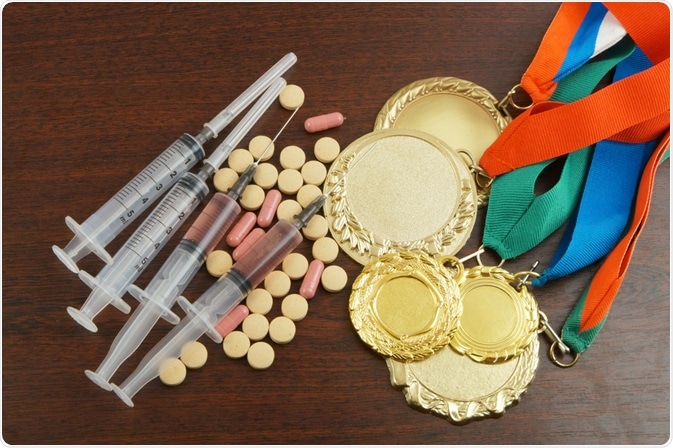Monitoring doping is an especially difficult analytical problem because several factors can make it problematic to interpret results. Some of the challenges include the broad spectrum of substances that can be present, the high sensitivity of detection required due to low micrograms per liter concentrations, the short turnaround time for results, and discriminating doping substances from other drugs in the system. The gold standard for overcoming these challenges is the use of mass spectrometry, usually coupled to a chromatographic technique.

Image Credit: Valery Evlakhov/Shutterstock.com
Mass Spectrometry
Mass spectrometry measures the mass to charge ratio of ions of a sample. The sample is ionized by subjecting the sample to a high influx of electrons. The resulting molecules in the sample become charged and either fragment or retain their whole structure.
These charged fragments and non-fragmented molecules separate according to their mass to charge ratio and are transported to a detector via the guided help of an electric or magnetic field. The resulting spectrum is the signal intensity of detected ions as a function of the mass to charge ratio and is used to elucidate the chemical structure.a
Chromatography-Mass Spectrometry
Gas chromatography-mass spectrometry (GC-MS) remains the standard approach for monitoring doping in athletes due to its high sensitivity and standardization. However, liquid chromatography-mass spectrometry (LC-MS) allows for minimal sample preparation, which enables high throughput analysis.
Furthermore, LC-MS allows for the detection of whole metabolic profiles of drugs, from the parent compound to polar conjugated metabolite species, thus making it easier to discriminate between doping and recreational use of drugs such as stimulants, narcotics, and cannabinoids.
World Anti-doping Agency (WADA)
The World Anti-doping Agency (WADA) has established criteria for the identification of a compound by chromatographic-mass spectrometric analysis. In the case of LC separation, the retention time of the analyte is required not to differ by more than 2% or ± 0.4 min from that of the same substance in the reference material.
In contrast, for MS detection, when a single-mass scan is acquired, all diagnostic ions with a relative abundance greater than 10% in the reference spectrum must be present in the unknown. Moreover, the relative abundance of the molecular ion or fragment ions shall not differ by more than a certain percentage relative to the base ion in the reference spectrum from the relative intensities of the same ions in the reference material. Some of the substances prohibited by WADA in sporting events that require the use of mass spectrometry as a technique for monitoring doping are listed below.
Stimulants
Stimulants prohibited from use in sporting events such as amphetamine and methylenedioxyamphetamine derivatives, cocaine, strychnine, and drugs that have a significant stimulating effect on the central nervous system can be detected using LC-MS.
A minimum required performance limit (MRPL) of 0.5 mg/L has been set by WADA for stimulants (and of 0.2 mg/L for strychnine). Quantitative thresholds in urine have been established for the other stimulants such as caffeine (12 mg/L), cathine (5 mg/L), methylephedrine (10 mg/L), and pseudoephedrine (25 mg/L). The use of LC-MS-MS with an ion trap has been reported to detect 25 analytes with limits of quantification (LOQ) in the range of 0.010 – 0.100 mg/L.
Narcotics
Prohibited narcotics include opiates heroin, hydromorphone, morphine, oxycodone, oxymorphone, and opioids methadone, pentazocine, pethidine, and dextromoramide. The required MRPL using LC-MS for narcotics is 0.2 mg/L.
The possibility to detect the whole metabolic profile of narcotics may provide an effective way to discriminate use for doping purposes at competition from other forms of opiate intake (e.g., use of codeine, consumption of foods containing poppy seeds) or even from recreational use.
Anabolic Agents
Anabolic agents prohibited in competition include exogenous anabolic androgenic steroids (AAS) such as boldenone, clostebol, fluoxymesterone, nandrolone, stanozolol, and analogs, endogenous AAS (androstenediol, androstenedione, dehydroepiandrosterone, dihydrotestosterone, testosterone, and analogs), the β2-agonist clenbuterol and zeranol, a non-steroidal estrogen analog. The MRPL using LC-MS for anabolic agents is 10 µg/L.
β-blockers
β-Blockers such as alprenolol, atenolol, betaxolol, labetalol, metoprolol, pindolol, propranolol, sotalol, and timolol) reduce the stimulatory effects of the nervous system by preventing noradrenaline from binding to its receptors and are used by athletes to reduce heart rate, which can be valuable in sporting activities where endurance and steadiness are important.
LC-MS-MS has been used as a method for the determination of 32 β-blocking agents for high throughput analysis of urine in doping control. The use of LC-MS and GC-MS techniques are generally used as the gold standard for the detection and monitoring of doping due to their high sensitivity and low limits of detection.
What is Gas Chromatography-Mass Spectrometry (GC-MS)?
References
- D.J. Borts and L.D. Bowers. Direct measurement of urinary testosterone and epitestosterone conjugates using high-performance liquid chromatography/tandem mass spectrometry. J. Mass Spectrom. 35:50-61 (2000).
- World Anti-Doping Agency, WADA Technical Document TD20031DCR (2003).
- R. Dams, C.M. Murphy, W.E. Lambert, and M.A. Huestis. Urine drug testing for opioids, cocaine, and metabolites by direct injection liquid chromatography/tandem mass spectrometry. Rapid Commun. Mass Spectrom. 17:1665-1670 (2003).
- P. Marquet. Progress of liquid chromatography-mass spectrometry in clinical and forensic toxicology. Ther. Drug. Monit. 24: 255-276 (2002).
- J.F. Van Bocxlaer, K.M. Clauwaert, W.E. Lambert, D.L. Deforce, E.G. Van den Eeckhout, and A.P. De Leenheer. Liquid chromatography-mass spectrometry in forensic toxicology. Mass Spectrom. Rev. 19:165-214 (2000).
- P.M. Clarkson and H.S. Thompson. Drugs and sport. Research findings and limitations. Sports Med. 24:366-384 (1997).
- M. Thevis, G. Opfermann, and W. Schanzer. High-speed determination of beta-receptor blocking agents in human urine by liquid chromatography/tandem mass spectrometry. Biomed. Chromatogr. 15" 393-402 (2001).
Further Reading
Last Updated: Sep 13, 2022